
Catalog excerpts

EPC 10 USB Patch Clamp Amplifier family EPC 10 USB Single EPC 10 USB Double EPC 10 USB Triple EPC 10 USB Quadro HEKA provides the finest instruments today to achieve the needed progress of tomorrow…
Open the catalog to page 1
Fully computer-controlled Patch Clamp Amplifiers HEKA is very proud to release the EPC 10 USB - the newest member of the EPC 10 family of fully computer-controlled patch clamp amplifiers. The EPC 10 USB continues the HEKA commitment to provide the most up-to-date and technologically advanced products for scientific research. The EPC 10 USB is the successor to the revolutionary EPC 9 patch clamp amplifier, which was introduced in 19901)2)3), as well as the renowned EPC 10. The EPC 10 USB patch clamp amplifier is available with either one (EPC 10 USB), two (EPC 10 USB Double), three (EPC 10...
Open the catalog to page 2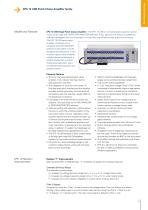
EPC 10 USB Patch Clamp Amplifier family EPC 10 USB Single Patch Clamp Amplifier – The EPC 10 USB is a complete data acquisition system, which can be used with HEKA’s PATCHMASTER software. A DLL (dynamic link library) is available for software developers who are interested in writing their own Windows data acquisition software. The EPC 10 USB patch clamp amplifier, combined with a computer and PATCHMASTER software is equivalent to a fullyequipped recording setup, which includes a patch clamp amplifier, a digital storage oscilloscope, a variable analog filter, a sophisticated pulse generator,...
Open the catalog to page 3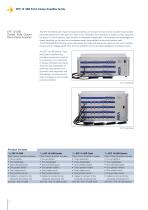
EPC 10 USB Double, Triple, Quadro Patch Clamp Amplifier The EPC 10 USB Double, Triple and Quadro amplifiers are the optimal instruments for performing multiple patch/cell experiments. Although two, three or four amplifiers are combined in a single housing, along with the built-in LIH 8+8 interface, each amplifier is completely independent. The amplifiers and headstages are clearly identified, so the user can immediately assign the amplifiers to particular patched cells. The PATCHMASTER software can simultaneously stimulate and acquire the response from each amplifier. Current and/or voltage...
Open the catalog to page 4
EPC 10 USB Patch Clamp Amplifier family Extending an EPC 10 USB Example 1 - EPC 10 Double + EPC Single Amplifier 3 Probes Example 2 - EPC 10 Triple + LIH 8+8 Interface 3 Probes + 9 A/D In + 5 D/A Out Example 3 - 2 x EPC 10 Quadro Amplifier 8 Probes with an LIH 8+8 The number of input and output channels available on the front panel of the EPC 10 USB family of amplifiers can be extended by combining an EPC 10 USB amplifier with an additional LIH 8+8 interface. This may be especially useful when using an EPC 10/n USB amplifier in which the number of available outputs is decreased...
Open the catalog to page 5
EPC 10 USB Patch Clamp Amplifier family Software Control Options PATCHMASTER The EPC 10 USB family of amplifiers can be controlled with PATCHMASTER software on either Windows (XP, Win7, Win8) or Mac (OS X 10.4+) platform. PATCHMASTER is a multi-channel stimulation/acquisition and control software. For more details please refer to the PATCHMASTER brochure. Complete amplifier control. Each amplifier control can be accessed through the software and many tasks such as compensation of capacitance values can be automated and executed on a single mouse click or button press. Amplifier parameters...
Open the catalog to page 6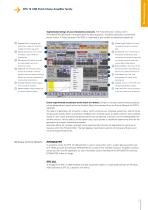
Sophisticated design of your stimulation protocols. The Pulse Generator window within PATCHMASTER defines all of the parameters for data acquisition, waveform generation and external device control. A Pulse Generator File (PGF) is comprised of any number of predefined sequences Sequence Pool: A paging bar that loads, saves, copies etc. the pool of available stimulation sequences. a Timing: Specification of the number of sweeps, sweep interval and sampling rate. 3 DA-channels: Multiple DA-channels and digital trigger lines can be selected for output. Segments: The stimulation pattern...
Open the catalog to page 7
EPC 10 USB Patch Clamp Amplifier family Red Star Headstage All EPC 10 USB patch clamp amplifiers are now shipped standard with the Red Star Headstage with improved noise performance. Especially the most relevant bandwidth between 1 and 10 kHz is now significantly improved. RMS noise values, Red Star Headstage EPC 10 vs. EPC 9 Headstage: • 1 kHz 31 fA vs 35 fA • 3 kHz 72 fA vs 90 fA • 5 kHz 120 fA vs 150 fA Features: • Improved noise performance in the important 1 – 10 kHz band • Three feedback resistors for three gain ranges, switchable during the experiment • Optimized for single-channel...
Open the catalog to page 8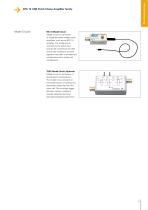
Model Circuits EPC 10 USB Patch Clamp Amplifier family MC 10 Model Circuit Model circuit for verification of single-electrode voltage clamp amplifiers, such as the EPC 10 amplifier. The model circuit connects to the probe input and can be switched to simulate one of tree conditions, an open pipette in the bath, a cell-attached configuration and a whole-cell configuration. TESC Model Circuit (Optional) Model circuit for verification of double patch configurations. The model circuit connects to two probe inputs, simulating two electrodes measuring from the same cell. Two switches toggle...
Open the catalog to page 9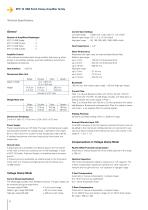
General Number of Amplifiers/Headstages Current Gain Settings Low gain range: 0.005, 0.01, 0.02, 0.05, 0.1,0.2 mV/pA up to 1 kHz: up to 3 kHz: up to 10 kHz: High gain range: up to 1 kHz: up to 3 kHz: up to 10 kHz: Amplifier Control Fully software controlled patch clamp amplifier featuring e.g. direct access to all amplifier settings, automatic calibration and self testing/diagnosis procedures. Host Interface USB 2.0 Dimensions Main Unit Dimensions Headstage D x W x H: (90 x 17 x 14.5) mm / (3.54 x 0.67 x 0.57) inch Power Supply Power requirements are 125 Watt. The logic controlled power...
Open the catalog to page 10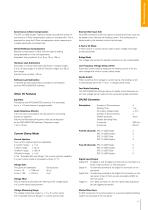
Synchronous C-Slow Compensation The EPC 10 USB Double, Triple and Quadro provide the option for synchronous C-Slow compensation pulses on multiple cells. This is essential for using the C-Slow compensation when measuring on multiple electrically connected cells. Series Resistance Compensation Maximal compensation is 95% with the optimal setting being dependent on the cell capacitance. Equivalent time constants: 2 ps, 5 ps, 10 ps, 100 ps Hardware Leak Subtraction Automatic or manual linear leak subtraction in all gain ranges: 0 to 2 nS (high range), 0 to 200 nS (medium range), 0 to 20 pS...
Open the catalog to page 11All Warner Instruments catalogs and technical brochures
-
Warner Instruments
28 Pages
-
DP-314
13 Pages
-
CHARTMASTER
6 Pages
-
Warner Full-line Catalog
426 Pages





